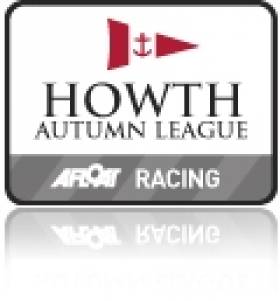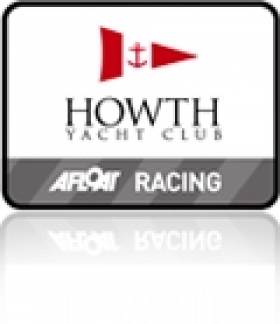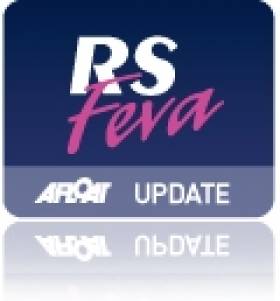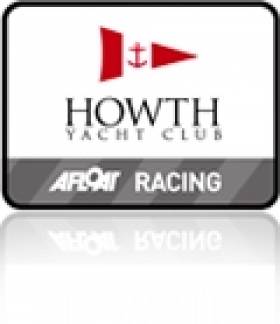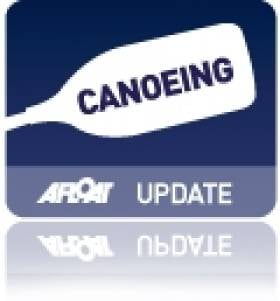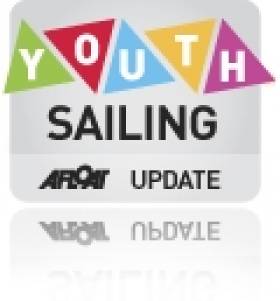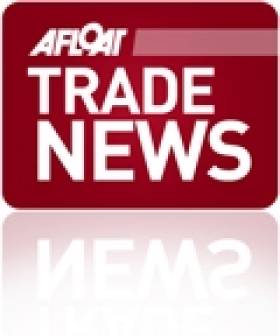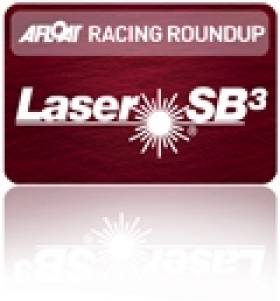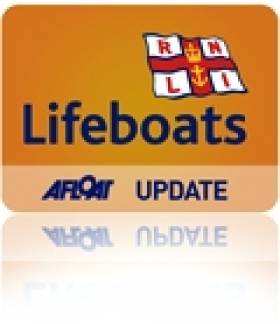Displaying items by tag: Howth
Shockwave Wins SB3 Howth Race
Trinculo Triumphs in IRC One
Oona's Race in Howth
The RS Feva Leinster Championships taking place at Howth Yacht Club were postponed today following gusts of over 40-knots in the race area. Today's sailing schedule was initially postponed before the championship was scrubbed at lunch time. The hope is to rerun the event later in the Summer.
Two races were completed on Saturday in 12 knots of wind in Howth sound.Louise Flynn Byrne and David Johnston started where they left off at the Mitsubishi Youth Nationals earlier this month and lead the 15 boat fleet ahead of Conor Totterdell and Stephen Craig of the RStGYC.
An error in rounding the windward mark ensured that Conor and Stephen won the first race, HYC's Claude Mollard and Jennie Harris were second and HYC's Nickie Delamer and Conor Howard came third.
With gusts of over 24 knots the race offer took the decision to shorten the course and allowed the sailors to return ashore. Race 2 was won by Louise and David, with Claude and Jenny in 2nd place and Conor Totterdell and Stephen Craig in 3rd.
Aura Tops the Seventeens in Howth
Irish Solo Circumnavigation by Kayak Approaches Dublin
Elaine 'Shooter' Alexander's epic challenge to become the first woman from Northern Ireland to circumnavigate Ireland by kayak is approaching Dublin's coastline.
The challenge will involve a solo voyage of 1000 miles battling tides, headlands, cliffs, not to mention unpredictable weather.
Elaine is just one week into her challenge having taken on a constant barrage of strong head winds en route to Dublin. She is currently just north of Drogheda and weather pending hopes to be in North Dublin (Skerries, Howth) tomorrow, passing Dublin Bay Friday, and South Dublin (Bray and Greystones) Saturday.
She is camping on route and would really appreciate somewhere to shower, store her boat etc close to the sea. You can see exactly where she is by scrolling down this post.
Royal Cork Yacht Club sailors have lifted two national titles at the 2011 Mitsubishi National Youth Sailing Championships this afternoon in a series cut short today by gale force winds on Dublin Bay. SCROLL DOWN FOR THIS AFTERNOON'S PRIZEGIVING PHOTOS.
Local knowledge offered no advantage as Dun Laoghaire co-hosts the Royal St. George YC, the National Yacht Club and the Royal Irish YC won none of the five national titles inspite of strong turnouts fielded by each of the waterfront clubs.
With winds gusting up to 25-30 knots and easterly winds causing a big swell, sailing for the final day of the ISA Mitsubishi National Championships was cancelled leaving the 300 sailors ashore. However all classes had completed sufficient races to complete the series.
The event was an important test event for Dun Laoghaire organisers of the Youth Worlds which will be held in the same venue from 12 -21 July 2012.
In a show of strength from the regions the three other titles went to other east coast clubs at Howth, Ballyholme and Courtown.
Immediately after the prizegiving, (photos below) Olympic Team Manager James O'Callaghan named the Irish team for the 2011 ISAF Youth World Championships in Croatia in July based on the weekend results. Listen to the podcast with the team manager, talking about the stand out performances of the weekend, the current strength of youth sailing in Ireland and the prospect of a top finish in Croatia.
Royal Cork YC achieved two national titles with Laser 4.7 event favourite Seafra Guilfoyle winning the title having previously dominated the Optimist fleet in previous years.
Brother and sister team Patrick & Chloe Crosbie also from Royal Cork won the 420 National title and Patrick was awarded the Training Grant for the most promising sailor at the event.
This event was the national trials for the Optimist class which was won by Tralee Bay sailor Sophie Browne who will travel to New Zealand in December to compete in the Optimist World Championships.
Irish optimist sailors are performing well internationally at the moment finishing fourth and fifth at the Braassemermeer Easter regatta. Other events during 2011 where there will be Irish representation include the European Championships in Portugal and the National Championships in Germany and the UK.
Top three results below. Click the links for full results class by class.
Laser Radial - full results here
National Champion: Philip Doran (Courtown Sailing Club)
2nd Robbie Gilmore (Strangford Lough YC)
3rd Eoin Keller (Lough Derg YC)
1st Girl Sophie Murphy Quoile Yacht Club
Laser 4.7 - full results here
National Champion: Seafra Guilfoyle (Royal Cork YC)
2nd Darragh O'Sullivan (Kinsale YC)
3rd Finn Lynch (NYC/Blessington SC)
1st Girl: Sian Kneafsey (National YC)
420 - full results here
National Champions: Patrick Crosbie & Chloe Crosbie (Royal Cork YC)
2nd Aodh Kennedy & Daniel Browne (Kinsale YC & Tralee Bay SC)
3rd Emma Geary & Niamh Connolly (Royal Cork YC & Baltimore SC)
Feva - full results here
National Champions: D Johnston & L Flynn Byrne (Howth YC)
2nd C Totterdell & S Craig (National YC/Royal St. George YC)
3rd C Mollard & J Harris (Howth YC)
Topper - full results here
National Champion: T Brow (Ballyholme YC)
2nd Laura Gilmore (Strangford Lough YC)
3rd Andrew Penney (East Antrim BC)
Optimist (Championship fleet)
1st Ben Walsh (Skerries SC)
2nd Ross Quirke (National YC)
3rd Colin O'Sullivan (Malahide YC)
Optimist National Trials
Sophie Browne (Tralee Bay SC) won the trials and took the option of travelling to New Zealand in December 2011 to represent Ireland at the Optimist World Championships.
The following sailors were selected by the trial process to represent Ireland at the European Championship which will be held in Portugal in July 2011: Sean Donnelly, HYC, Peter McCann RCYC, Harry Whitaker RCYC, Eoin Lyden RCYC, Jil McGinley RCYC Cliodhna Ni Shuilleabhain KYC and Megan Parker SSC
The team selected to travel to the German National Championships include Robert Dickson HYC , Daire Cournane KYC, Sean Waddilove Skerries SC, Richard Hogan HYC, Adam Hyland RSGYC, Ronan Cournane KYC, Sean Gambier Ross KYC and Fergus Flood HYC, Aoife Hopkins and Alacoque Daly Tralee Bay SC.
In addition 10 sailors were chosen for the Irish under 12 squad who will compete in the Optimist UK National Championships.
All our youth sailing news aggregated here
Prizegiving photos by Gareth Craig below. For daily on the water action: Day one photos here. Day two photos here. Day three photos here.
Healthy Discounts Give Irish Boat Sales a Lift
Any upturn couldn't come quick enough though. The Irish Marine Federation (IMF) is counting the cost of recession that has reduced its membership by up to two thirds as marine firms closed their doors.
"For the first time in three years I'm seeing fresh enquires and importantly new blood coming into Irish boating, said Bernard Gallagher of BJ Marine in Malahide, north Dublin.
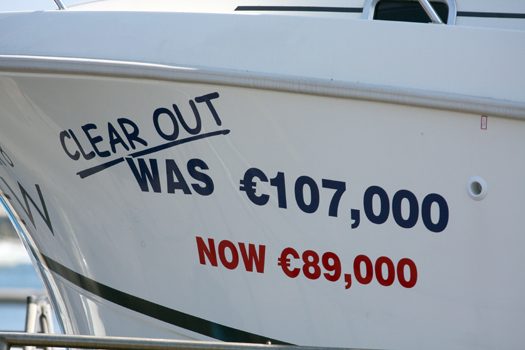
Boat dealers are offering substantial discounts
The new confidence in Irish boat buyers is primarily being seen in the sailing boat market.
One of the most accurate barometers of marine leisure activity, some dealers are reporting a return business levels not seen for three or four years.
"We've just sold a lovely 38-footer in to Howth and we've more sales in the pipeline said" Gallagher.
Other dealers confirm the same saying there is definitely a positive mood among buyers to go the extra step in the sales process.
It's quite a turnaround because up until very recently, dealers admit there was 'no boat buying mood at all'.
Ironically though after such poor sales at home there's now a real shortage of boats for sale here because over the past few years a lot of Irish boat stock was sold abroad.
"We badly need boats for our brokerage listings", says Gallagher who also operates branches in Belfast and Malta.
Many say sales will never get back to the dizzy heights of 2006 but for now good product ranges at the right place plus a splash of Easter sunshine is helping to move things at least a step in the right direction.
Irish dealers have been resourceful in finding markets abroad and an example of this is Dun Laoghaire dealer MGM boats who has just returned from the Portuguese boat show where there was positive vibes in Villamoura despite the recent bailout there too!
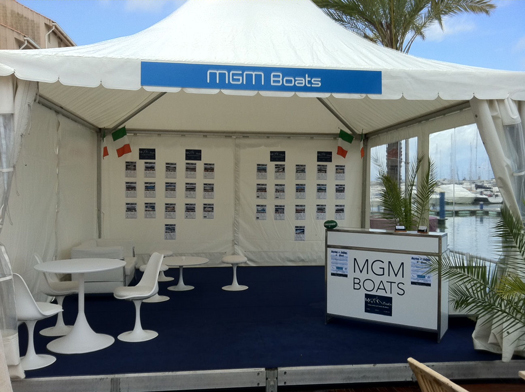
The MGM Boats Stand at the recent Villamoura Show
Annalise Murphy Lines up for SB3 Eastern Championships in Howth
Unless last year's champion Gareth Flanigan and his crew can beg, steal or borrow a boat, they won't be able to defend their title and a new winner will be crowned on May 1st. The recent Spring Warmer Series saw some boats post inconsistent results while two teams in particular stepped up from last year to place themselves in the running.
Eoin Quinlan's decision to team up with Mike Evans and Peter Frane with 'Shockwave' looked like a smart one, with consistent results putting them on top of that series, and giving them the confidence to make the top 3 or 4 places at the Easterns.
John O'Driscoll of the Royal St.George is another skipper in flying form and will be hopeful of a good overall result next weekend. HYC's own 'Sharkbait' (Ben Duncan/Brian Moran/Rick Morris) can never be under-estimated and will be tipped to be among the prime contenders.
A feature of the event is the entry of several women helms, the most notable being Olympic hopeful Annalise Murphy of the National YC with her mother (and former Olympian) Cathy MacAleavey crewing.
Howth Lifeboat Assists Speedboat Captured on Video
On Sunday night, Howth Inshore Lifeboat assisted two people aground in a five metre speedboat North of Malahide estuary in Co. Dublin. Scroll down for the three minute RNLI video of the rescue.
In a joint operation in March, Howth Coast Guard and Howth lifeboat rescued a teenage girl who collapsed on Howth Head. The teenager had walked down a 100 foot steep cliff path to Jameson Beach on Howth Head with her friends when she collapsed. Gardai arrived on the scene and requested Coast Guard assistance to extract the casualty. Video and RNLI Video here.


























